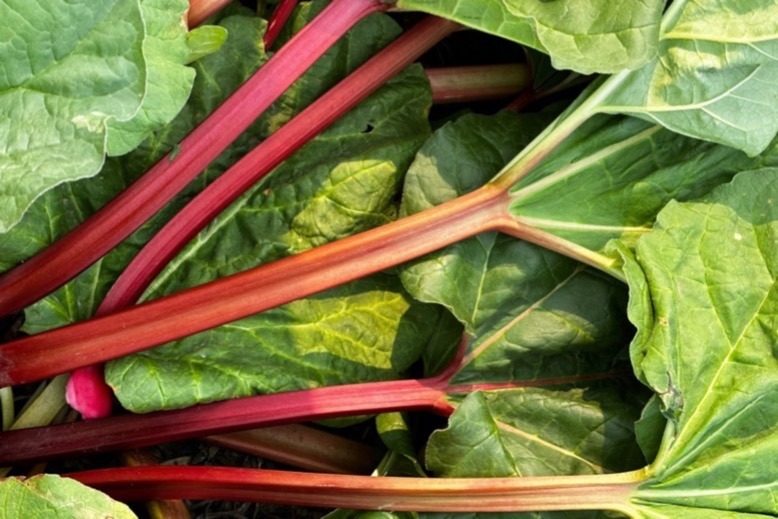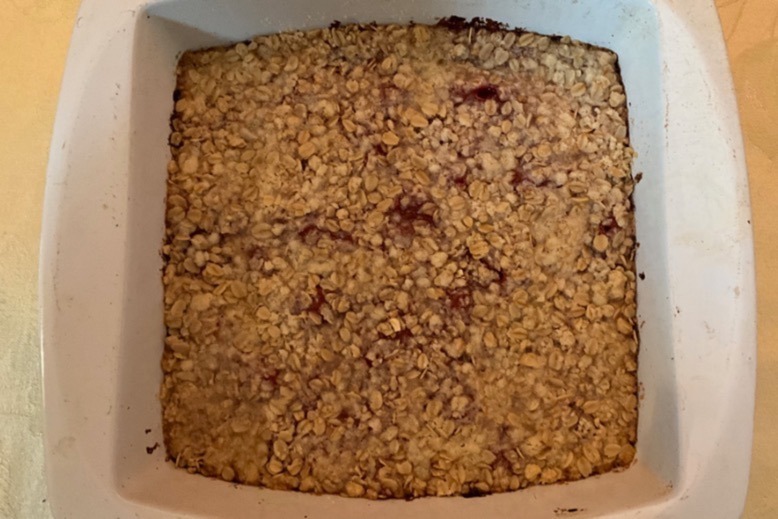
Because we tend to eat rhubarb sweetened and in desserts, many think of it as a fruit. But it’s actually a vegetable—a flowering member of the buckwheat family, to be exact—that looks like very big, red-hued celery.
But resemblance is where the similarity to celery ends. Unlike celery, rhubarb is never eaten raw; it’s cooked and sweetened into a delicious, sweet-tart pie filling oran alternative to applesauce.
According to the Farmers’ Almanac, rhubarb originated in Asia, reached Europe in the 1600s, and was introduced in America soon thereafter. Because it thrives in cooler climates, it’s a popular crop in New Jersey and other northern parts of the U.S., and is typically available from early spring through early summer.
There are basically two types of rhubarb. One is field-grown rhubarb, characterized by broad, deep pink-to-red stalks, sometimes streaked with green. The other type, hothouse-grown, features much smaller stalks that are a lighter, softer pink color. The latter type is usually more tender than field-grown rhubarb. It’s nearly always stringless, but is more expensive and available mainly in upscale produce stores.
Rhubarb is high in antioxidants that help protect against cancer, heart disease and diabetes. It’s also a rich source of vitamins C and K, plus potassium, which help fight inflammation, reduce bad cholesterol, brighten skin and strengthen bones.
SELECTION & STORAGE
When selecting rhubarb, look for firm, crisp stalks without spots or dark patches. Because its leaves are poisonous and should not be eaten, rhubarb is usually sold with its leaves already cut off. If leaves are still attached, they should be stiff and vivid green; avoid rhubarb that has wilted leaves or flabby stalks.
On field-grown rhubarb, the youngest stems—on which the leaves aren’t fully grown—are more tender and delicately flavored than the larger stalks.
After purchasing rhubarb, remove any leaves. Store it in the refrigerator, unwashed, in a plastic bag, for as long as a week.
PREPARATION
Rhubarb is sold ripe and, as long as its leaves have been removed, ready to be washed and cooked. As mentioned, its leaves contain toxic quantities of oxalic acid, a compound that can irritate the stomach and interfere with the absorption of some nutrients. So be sure to remove and discard all the leaves before cooking. If the stalks are especially big, tough or stringy, you can peel them as you would celery.
Rhubarb is great steamed, stewed or baked with sugar. For the simplest preparation, wash the stalks, cut into ½- to 1-inch pieces, add a little sugar and just enough water to submerge them, and cook, uncovered, until tender—around 10 minutes, depending on the tenderness of the stalks. (Start with about half a cup of sugar per pound of rhubarb, tasting and adjusting for sweetness near the end of the cooking portion.)
Rhubarb is sometimes mixed with apples in recipes, and it also makes a great companion to strawberries. Add the strawberries when the rhubarb is nearly done cooking, then spoon the mixture over ice cream or shortcake. Better yet, make a traditional strawberry-rhubarb pie, which is one of my personal favorites.
For a delicious and easy-to-bake twist on strawberry-rhubarb pie, check out the following recipe from my friend Dana Kuehm of the family-owned Farms View Farm Market in Wayne. Dana’s strawberry-rhubarb bars are tasty and hearty, and lend themselves perfectly to the star ingredient’s sweet-yet-tart flavor profile.
Wishing everyone a happy summer!
DANA’S DELICIOUS STRAWBERRY-RHUBARB BARS

Bette Napolitano’s version of Dana’s Kuehm’s strawberry-rhubarb bars. Photo: Courtesy of Pete Napolitano
Crust:
- 1½ cups quick-cooking rolled oats
- 1 cup flour
- ¾ cup butter (12 tablespoons)
- ½ cup sugar
Filling:
- 2 cups strawberries, chopped or diced
- 1½ cup rhubarb, chopped or diced
- ¼ cup sugar
- ¼ cup water
Preheat oven to 350 degrees. Butter an 8-by-8-by-2–inch glass dish. Stir together oats, flour and sugar, then cut in the butter using a fork or pastry blender. Mix until crumbs form and set aside 2 cups for topping. Press remaining crumb mixture into bottom of pan and bake for 20 minutes. Allow the dish to completely cool (don’t skip this step!).
In a saucepan, combine rhubarb, sugar and water. Cook and stir for 8–10 minutes until thickened and bubbly. Stir in chopped strawberries and pour over cooled, baked crust.
Sprinkle reserved crumbs evenly over rhubarb filling, press down lightly on crumbs, and bake for 30–35 minutes (or until top is golden brown and filling is bubbly). Cut into bars of desired length, and enjoy!
About “Produce Pete” Napolitano
With over 65 years of experience in the produce industry, New Jersey’s own “Produce Pete” Napolitano is a renowned fruit and vegetable expert, author and TV personality who’s appeared on a highly popular segment on NBC’s Weekend Today in New York Saturday mornings for over 28 years. His memoir, They Call Me Produce Pete, is out now. For more information, visit producepete.com.
About Susan Bloom
A regular contributor to New Jersey Monthly and a variety of other well-known local and national publications, Susan Bloom is an award-winning New Jersey-based freelance writer who covers topics ranging from health and lifestyle to business, food and more. She’s collaborated with Produce Pete on a broad range of articles for over a decade.
No one knows New Jersey like we do. Sign up for one of our free newsletters here. Want a print magazine mailed to you? Purchase an issue from our online store.



